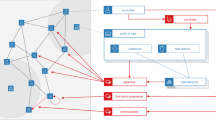Abstract
Online auctions for perishable products have tremendous potentials. However, the current forms of online auctions do not take full advantages of information technology enabled online auctions, and are ineffective for online auctions for perishable products. This study proposes a virtual competition auction model for perishable products. In virtual competition auctions, the bidder is provided with auction historical data, and the bidder’s decision is represented by a demand curve that is composed of a series of bids. A preliminary laboratory experiment based on a prototype of virtual competition auction system is reported. The preliminary laboratory experiment result shows that the virtual competition auction model for perishable products is more effective than the ordinary open-cry auction model.




Similar content being viewed by others
References
Akerlof, G. A. (1970). The market for ‘Lemons’: quality uncertainty and the market mechanism. Quarterly Journal of Economics, 84(3), 488–500.
Amazon (2010). <http://www.amazon.com> [Accessed September 25, 2010].
Arminas, D. (2001). Online auctions take off far KLM. Supply Management, 6(22), 10.
AuctionSentry (2010). <http://www.auctionsentry.com/> [Accessed September 25, 2010].
AuctionStealer (2010). <http://www.auctionstealer.com/home.cfm> [Accessed September 25, 2010].
Bapna, R. (2003). When snipers become predators: can mechanism design save online auctions? Communications of the ACM, 46(12), 152–158.
Bapna, R., Goes, P., Gupta, A., & Karuga, G. (2002). Optimal design of the online auction channel: analytical, empirical, and computational insights. Decision Sciences, 33(4), 557–577.
Bapna, R., Goes, P., & Gupta, A. (2003). Analysis and design of business-to-customer online auctions. Management Science, 49(1), 85–101.
Brint, A. T. (2003). Investigating buyer and seller strategies in online auctions. Journal of the Operational Research Society, 54, 1177–1188.
Cui, X., Lai, V., & Liu, C. (2008). Research on consumer behavior in online auctions: Insights from a critical literature review. Electronic Markets, 18(4), 345–368.
Daus, S., & Tong, C. (2010). Dynamic pricing when consumers are strategic: analysis of posted and contingent pricing schemes. European Journal of Operational Research, 204, 622–671.
eBay (2010). <http://www.ebay.com> [Accessed September 25, 2010].
eShop (2010). Auctions, <http://auctions.msn.com/Scripts/glossary.asp> [Accessed September 25, 2010].
eSnipe (2010). <http://www.esnipe.com/> [Accessed September 25, 2010].
Gopal, R., Thompson, S., Tung, Y. A., & Whinston, A. B. (2005). Managing risks in multiple online auction: an options approach. Decision Sciences, 36(3), 397–425.
Heyman, J. E., Orhun, Y., & Ariely, D. (2004). Auction fever: the effect of opponents and quasi-endowment on product valuations. Journal of Interactive Marketing, 18(4), 7–21.
Ho, J. K., Chu, S., & Lam, S. S. (2007). Maximum resolution topology for online auction markets. Electronic Markets, 17(2), 164–175.
Klein, S., & O’keefe, R. M. (1999). The impact of the Web on auctions: some empirical evidence and theoretical considerations. International Journal of Electronic Commerce, 3(3), 7–20.
Liu, H., Wang, S., & Teng, F. (2003). Multicast-based online auctions. Benchmarking: An International Journal, 10(1), 54–64.
Lucking-Reiley, D. (2000). Auctions on the Internet: what’s being auctioned, and how? The Journal of Industrial Economics, 48, 227–252.
Marcoux, A. M. (2003). Snipers, stalkers, and nibblers: online auction business ethics. Journal of Business Ethics, 46(2), 163–169.
McAfee, R. P., & McMillan, J. (1987). Auctions and bidding. Journal of Economic Literature, 25, 699–738.
McCabe, K., Rassenti, S., & Smith, V. (1999). Designing auction institutions for exchange. IIE Transactions, 31, 803–811.
Milgrom, P., & Weber, R. J. (1982). The value of information in a sealed-bid auction. Journal of Mathematical Economics, 10(1), 105–114.
O’Brien, L. (2001). The price is right. Supply Management, 29, 28–29.
Oliverira, R., Pozzebon, M., & Heck, E. V. (2007). Veiling Holambra - Trading Brazilian flowers in the international market enabled by IT. Journal of Information Technology Case and Application Research, 9(1), 38–52.
Pinker, E. J., Seidmann, A., & Vakrat, Y. (2003). Managing online auctions: current business and research issues. Management Science, 49(11), 1457–1484.
Reck, M. (1997). Trading-process characteristics of electronic auction. Electronic Markets, 7(4), 17–21.
Skitmore, M. (2001). Graphical model for identifying high outliers in construction contract auctions. The Journal of the Operational Research Society, 52, 800–809.
TheBidFloor (2010). <http://www.thebidfloor.com/buyers_sniping_software.htm> [Accessed September 25, 2010].
Trautmann, S. T., & Traxler, C. (2010). Reserve price as reference points—evidence from auctions for football players at Hattrick.org. Journal of Economic Psychology, 31(2), 230–241.
Turban, E. (1997). Auctions and bidding on the Internet: an assessment. Electronic Markets, 7(4), 7–11.
van Heck, E., & Ribbers, P. M. (1997). Experiences with electronic auctions in the Dutch flower industry. Electronic Markets, 7(4), 30–34.
Vickrey, W. (1961). Counter-speculation, auctions, and competitive sealed tenders. Journal of Finance, 41, 8–37.
Vishwanath, A., & Barnett, G. A. (2005). An empirical investigation into the structure of bidding in online auctions. Electronic Markets, 15(3), 261–273.
Wang, S. (2002). Synchronous online open-cry auctions. INFOR: Journal of Information Systems and Operational Research, 40(1), 86–94.
Acknowledgement
The comments of the Editor and two anonymous reviewers have contributed significantly to the revision of the article. The second author is supported in part by Natural Sciences and Engineering Research Council of Canada (NSERC Grant 312423).
Author information
Authors and Affiliations
Corresponding author
Additional information
Responsible editor: Hans-Dieter Zimmermann
Appendix
Appendix
Rights and permissions
About this article
Cite this article
Wang, S., Wang, H. A virtual competition auction model for perishable products. Electron Markets 21, 53–62 (2011). https://doi.org/10.1007/s12525-011-0049-z
Received:
Accepted:
Published:
Issue Date:
DOI: https://doi.org/10.1007/s12525-011-0049-z




